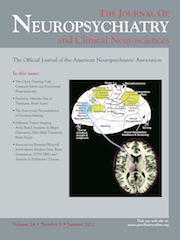Metoclopramide-Induced Tardive Respiratory Dyskinesia
To the Editor: Metoclopramide is a dopamine-receptor antagonist FDA approved for the treatment of nausea, vomiting, and diabetic gastroparesis.1 In addition to its effect on the gastrointestinal tract, metoclopramide crosses the blood–brain barrier to antagonize dopamine type-2 (D2) receptors in the chemoreceptor trigger zone. However, metoclopramide also antagonizes D2 receptors in the nigrostriatal and striatopallidal pathways, similar to antipsychotics, which may lead to extrapyramidal side effects (EPS), including tardive dyskinesia (TD). Respiratory dyskinesia (RD) is a respiratory manifestation of TD and can present as irregular respiration, dyspnea, gasping, or abnormal esophageal movements.2 Metoclopramide has a black box warning for TD associated with long-term use. There have also been case reports of worsening dyskinesias upon metoclopramide discontinuation.3,4 Therefore, it is feasible that metoclopramide can cause a wearing-off respiratory dyskinesia. Here we describe the first case of RD after metoclopramide discontinuation.
Case Report
A 78-year-old African American woman with a history of diabetes and hypertension presented to the emergency department (ED) with a respiratory rate of 45 respirations per minute, complaining of shortness of breath, intermittent chest pain, and headaches. An arterial blood gas revealed respiratory alkalosis, with a pH of 7.69 and pCO2 of 17mm/Hg. The patient had two previous similar presentations with unrevealing diagnostic evaluation. The ED evaluation found normal cardiac enzymes, and an electrocardiogram was negative for ischemia. While in the ED, she received 0.5 mg of lorazepam intravenously and her breathing improved to 20 inhalations per minute. The patient was admitted for further evaluation and treatment, her third hospitalization in 3 months for dyspnea, tachypnea, and anxiety. Pertinent psychotropic medications on admission included lorazepam 1 mg as needed for anxiety and fluoxetine 40 mg every morning.
The patient described her symptoms as a choking sensation causing difficulty breathing, which in turn caused anxiety. A barium-swallow evaluation was performed to explore gastrointestinal causes of her symptoms, which showed normal esophageal dimensions and motility. Echocardiogram was similar to previous, showing normal ejection fraction and mild left-ventricular hypertrophy. The patient was noted to have lip-smacking, mouth puckering, movement of the forehead and blinking, consistent with tardive dyskinesia (TD). On further clinical evaluation, choreiform and dyskinetic movements of the right arm, thoracic, and abdominal muscles were observed concurrent with increased respiratory rate and complaints of shortness of breath and anxiety. Abnormal Involuntary Movement Scale (AIMS)5 score was 37. Symptoms were consistent with respiratory dyskinesia, resulting in dyspnea, anxiety, and hyperventilation. Pulmonary function tests were unremarkable, save for a reduction in maximal voluntary ventilation, which can be related to neuromuscular dysfunction, including dyskinesia.
A review of the medical record revealed a history of diabetic gastroparesis treated with metoclopramide for 6 years. Metoclopramide was discontinued 4 months before the current admission for unknown reasons. Note of perioral dyskinesia was made during an admission 2 months earlier. Studies during previous hospitalizations included normal serial cardiac enzymes, electrocardiograms without signs of ischemia, two very low probability ventilation/perfusion scans, and clear chest X-rays. Given this unrevealing diagnostic work-up, an anxiety disorder had been suspected.
During this admission, the patient was restarted on metoclopramide 5 mg three times daily. Clonazepam 0.5 mg at bedtime was added and lorazepam prn discontinued to target dyskinesia and secondary anxiety symptoms, with benefit. The patient’s AIMS score decreased from 37 to 11, and she reported feeling significantly improved. The patient has not had any hospitalizations at our institution since.
Discussion
Based on the Drug Withdrawal Probability Scale, this adverse reaction scored 5 points, indicating that RD reaction following metoclopramide withdrawal is probable.6 No cases of metoclopramide-induced RD exist in the literature; however, cases of RD have been reported with long-term antipsychotic use.2 Risk factors for developing RD include advanced age, length of drug exposure, higher cumulative dose, female gender, and organic mental disorders.7 Treatment of RD often involves tapering off the offending agent; however, in some cases, tapering the dose or discontinuing the medication may actually worsen symptoms. This phenomenon may be due to increased dopaminergic activity in extrapyramidal structures upon drug withdrawal.3 Worsening EPS upon metoclopramide discontinuation has been reported in two patients prescribed clinical doses of this medication.3,4 Patients should be monitored for dyskinesias, including those leading to dyspnea, not only while taking metoclopramide, but also upon its discontinuation.
1 : Review article: metoclopramide and tardive dyskinesia. Aliment Pharmacol Ther 2010; 31:11–19Crossref, Medline, Google Scholar
2 : Neuroleptic-induced respiratory dyskinesia. J Neuropsychiatry Clin Neurosci 1995; 7:223–229Link, Google Scholar
3 : Acute dyskinesias after metoclopramide withdrawal. J Am Geriatr Soc 1997; 45:536Crossref, Medline, Google Scholar
4 : Withdrawal effects of metoclopramide. West J Med 1991; 154:726–728Medline, Google Scholar
5 : Abnormal Involuntary Movement Scale (AIMS). ECDEU Assessment Manual for Psychopharmacology. Washington, DC, U.S. Department of Health Education and Welfare, 1976, pp 534–537Google Scholar
6 : A method for estimating the probability of adverse drug reactions. Clin Pharmacol Ther 1981; 30:239–245Crossref, Medline, Google Scholar
7 : Respiratory dyskinesia. An underrecognized phenomenon. Chest 1994; 105:1826–1832Crossref, Medline, Google Scholar



